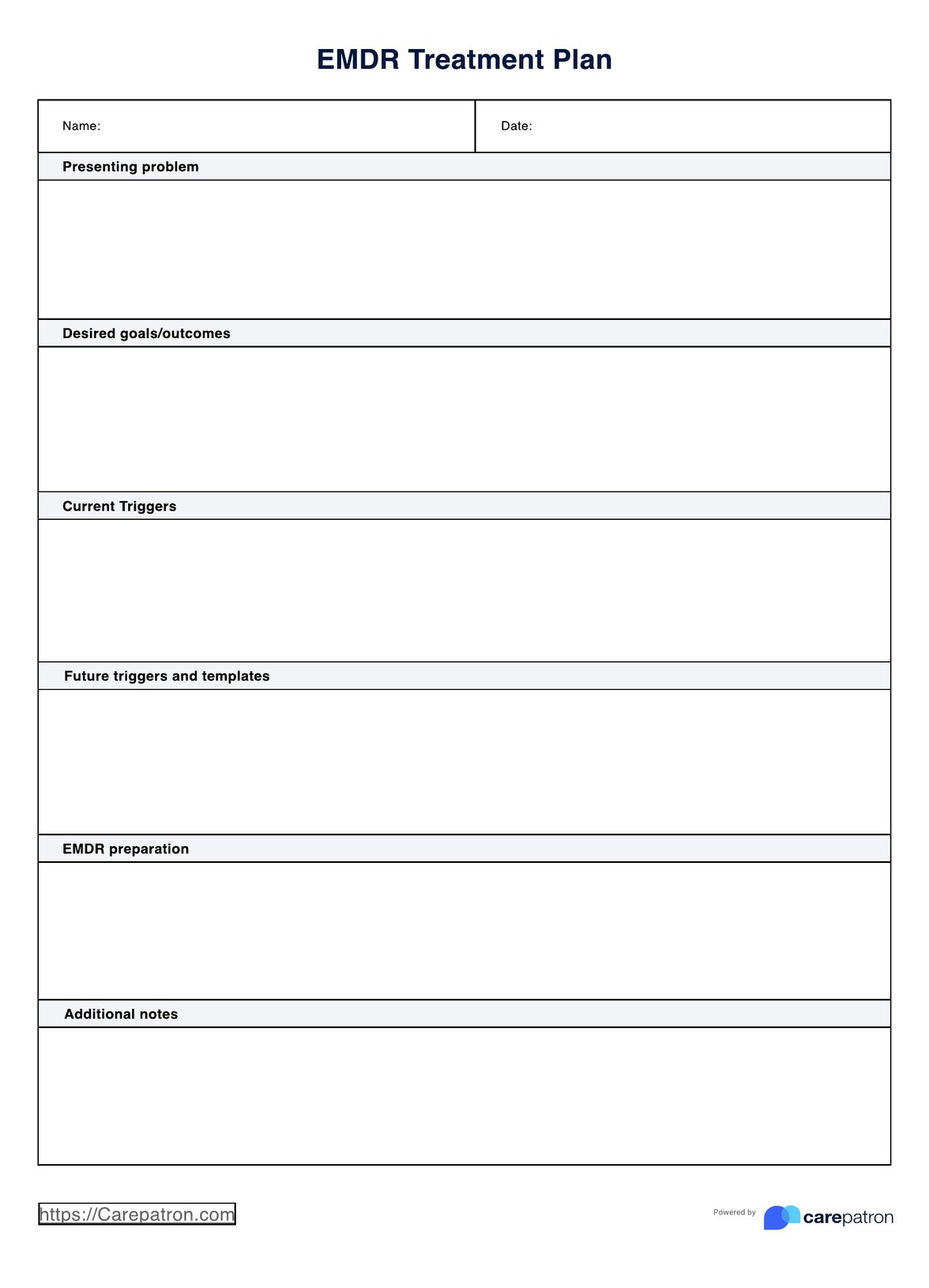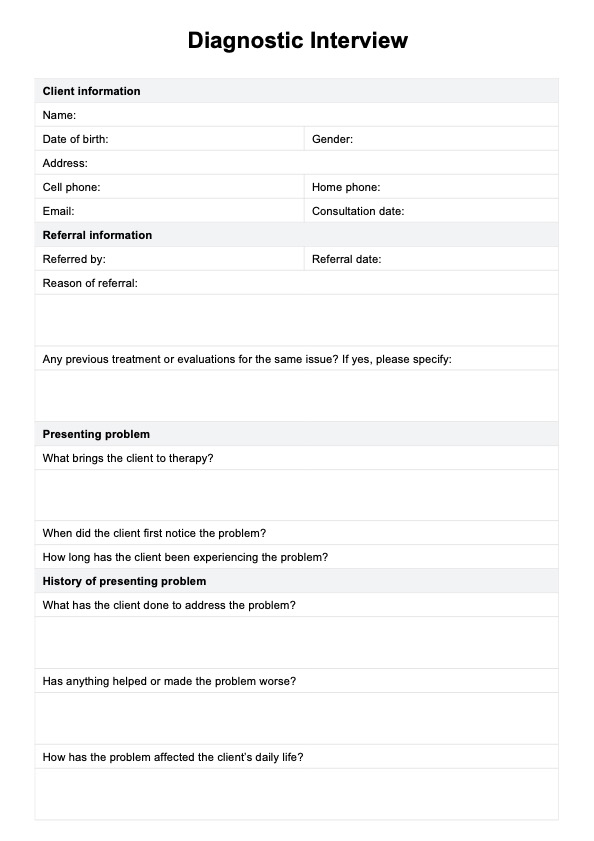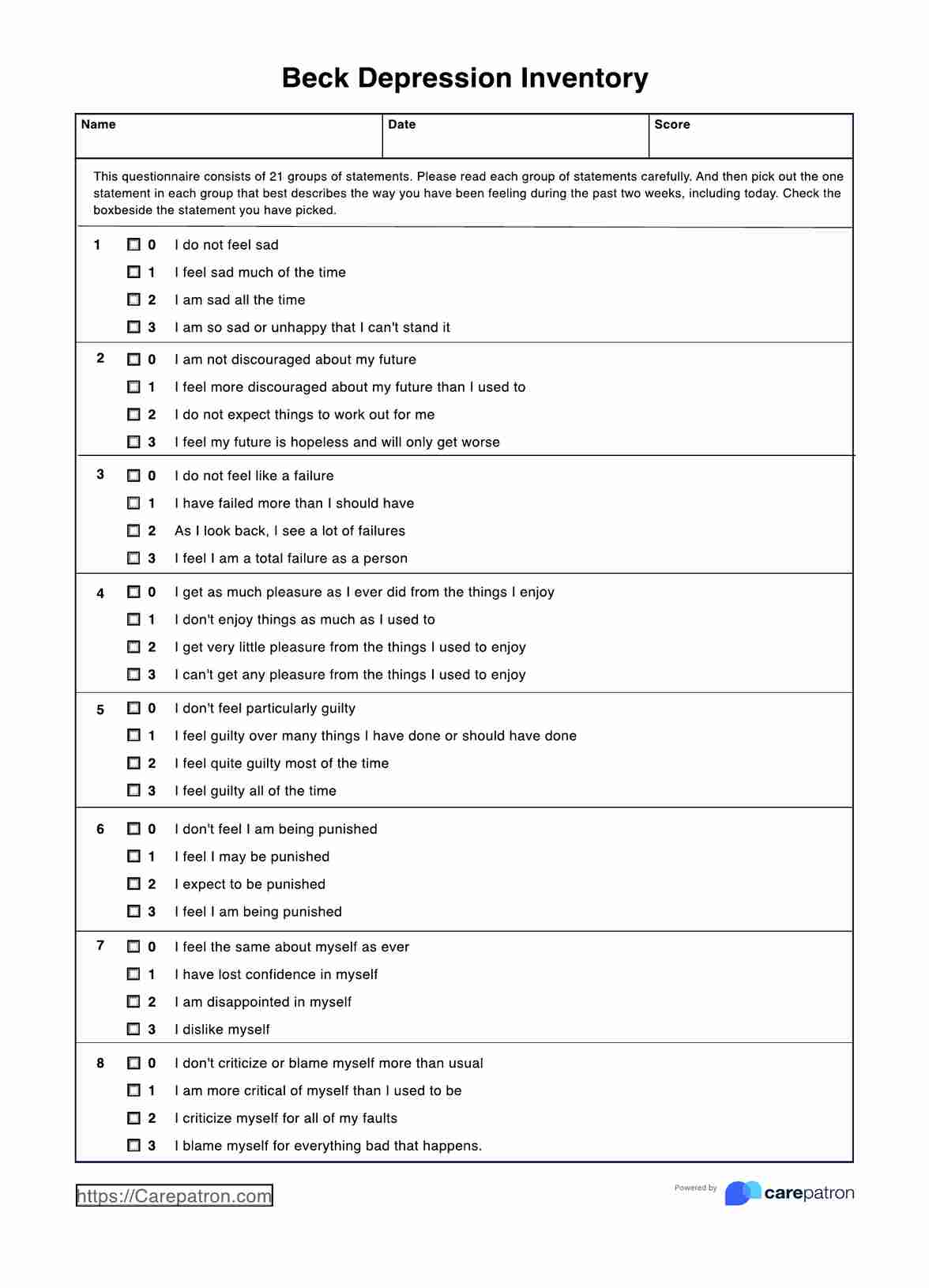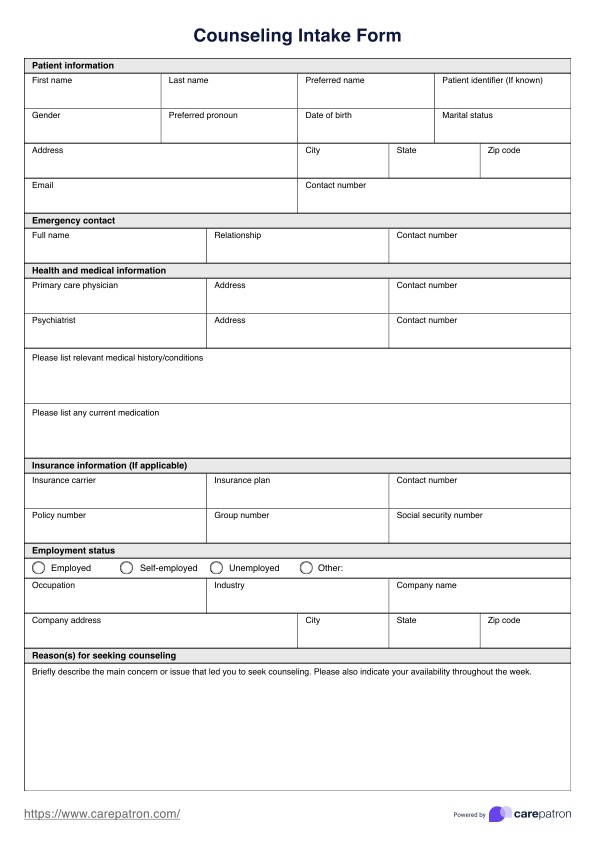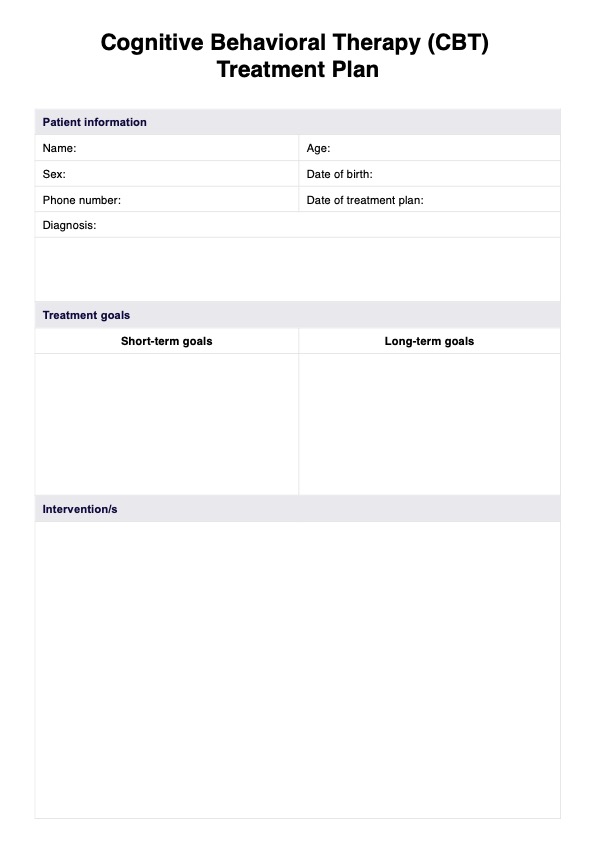Person-Centered Therapy Treatment Plan
Explore the transformative journey of Person-Centered Therapy. Download a free PDF example treatment plan for self-discovery and empowerment.


What is person-centered therapy?
Person-centered therapy, developed by renowned psychologist Carl Rogers, is a humanistic approach that places paramount importance on the individual's subjective experience and self-exploration. This therapeutic model's core is establishing a positive therapeutic relationship between the client and the therapist.
Unlike some therapeutic approaches, Person-Centered Therapy does not rely on predetermined techniques; instead, it emphasizes creating a nurturing environment that allows clients to explore their thoughts and emotions at their own pace.
The success of Person-Centered Therapy lies in its ability to foster a positive therapeutic relationship, which is instrumental in facilitating personal growth and self-acceptance. This approach contrasts with more structured therapies like cognitive behavioral therapy (CBT). Rather than focusing on specific techniques, Person-Centered Therapy prioritizes creating a safe and non-judgmental space where clients feel empowered to express themselves openly. This emphasis on autonomy aligns with the principles of positive psychology, encouraging individuals to explore and build on their strengths.
In successful Person-Centered Therapy, the therapist adopts an empathetic and non-directive stance, allowing clients to navigate their inner world freely. The approach is founded on the belief that individuals possess an innate drive towards self-actualization and personal development. By fostering a supportive atmosphere, therapists in this model strive to unlock the client's potential for positive change, ultimately contributing to a more fulfilling and authentic life journey.
Person-Centered Therapy Treatment Plan Template
Person-Centered Therapy Treatment Plan Example
Techniques commonly used in person-centered therapy
Embarking on the transformative journey of Person-Centered Therapy involves delving into a unique therapeutic approach rooted in empathy, acceptance, and client-centeredness. In this section, we explore the techniques that form the bedrock of Person-Centered Therapy, shedding light on the art of active listening, empathetic understanding, and the nuanced application of these strategies in addressing issues ranging from negative emotions to anxiety disorders and post-traumatic stress disorder.
Client-centered therapy
At the heart of Person-Centered Therapy is the principle of client-centeredness. This technique prioritizes the client's experience, allowing them to lead discussions and decisions. Therapists employing this technique create a non-judgmental and accepting space where clients can explore their thoughts and emotions without imposed directives.
Active listening
Active listening is a fundamental technique in Person-Centered Therapy. Therapists engage in attentive and reflective listening, providing clients with the profound experience of feeling heard and understood. Through this technique, therapists demonstrate a genuine interest in the client's narrative, fostering trust and openness.
Empathetic understanding
Empathy plays a crucial role in Person-Centered Therapy. Therapists strive to understand the client's perspective, demonstrating a deep sense of empathy. This technique involves acknowledging and validating the client's emotions, fostering a connection that encourages further self-exploration.
Addressing negative emotions
Person-centered therapy encourages the exploration of negative emotions without judgment. Therapists assist clients in understanding and accepting their negative feelings, facilitating a constructive dialogue that can lead to personal growth and emotional resilience.
Post Traumatic Stress Disorder (PTSD) support
Person-centered therapy can be adapted to support individuals with PTSD. By providing a safe space and utilizing empathetic techniques, therapists help clients process traumatic experiences at their own pace, promoting healing and coping.
Anxiety disorders management
In addressing anxiety disorders, Person-Centered Therapy focuses on creating a therapeutic environment that alleviates anxiety. The client is encouraged to explore and express their anxious thoughts and feelings, fostering a sense of control and self-efficacy.
Integration with cognitive therapy
While Person-Centered Therapy is distinct from cognitive therapy, some therapists integrate mental elements to address specific issues. This may involve collaboratively exploring and challenging maladaptive thoughts, contributing to a more holistic therapeutic approach.
These techniques collectively contribute to the effectiveness of Person-Centered Therapy, emphasizing the importance of a supportive and collaborative therapeutic relationship in promoting self-discovery and personal growth.
Why are treatment plans important in therapy?
In the realm of mental health, treatment plans play a pivotal role in guiding both mental health professionals and their clients through the intricate terrain of psychological well-being. Person-centered therapy, renowned for its emphasis on the individual's subjective experience, benefits significantly from formulating a comprehensive treatment plan. These plans, often crafted collaboratively between therapist and client, not only outline specific person-centered therapy techniques but also set clear objectives, milestones, and a timeline for the therapeutic process.
Armed with treatment plans, mental health professionals can strategically integrate person-centered techniques like active listening and empathetic understanding into sessions. This structured approach helps address immediate concerns and contributes to the broader goal of facilitating therapeutic personality change. By delineating a path toward positive mental health outcomes, treatment plans provide a sense of direction and purpose, instilling confidence in both the therapist and the client.
Furthermore, the significance of treatment plans extends beyond individual therapy sessions, finding relevance in diverse therapeutic contexts, including family therapy. In family-oriented approaches, treatment plans become invaluable tools for fostering understanding and collaboration among family members. They enable mental health professionals to tailor interventions that consider the dynamics of the entire family system, addressing collective and individual needs.
Ultimately, treatment plans are more than mere administrative documents; they embody a commitment to the client's well-being and serve as dynamic guides that evolve as the therapeutic journey unfolds. In person-centered therapy and beyond, these plans foster a collaborative and goal-oriented approach, paving the way for lasting mental health improvements and transformative personal growth.
How does this treatment plan work?
Step 1: Establishing client information
The initial step involves gathering essential information about the client, such as their name, date of birth, and contact details. This foundational data ensures personalized and client-centered care throughout the therapeutic process.
Step 2: Defining goals and objectives
In Step 2, the therapist collaborates with the client to outline short-term, medium-term, and long-term goals. These goals are the guiding compass for the therapeutic journey, aligning with the principles of person-centered therapy and client-centered approaches.
Step 3: Person-centered therapy techniques
This section delineates specific person-centered therapy techniques to be employed. Emphasis is placed on active listening, empathetic understanding, and utilizing client-centered approaches. These techniques, rooted in unconditional positive regard, create an environment conducive to self-expression and self-exploration.
Step 4: Assessment and progress monitoring
Regular assessments are conducted to measure progress toward established goals. This step involves feedback loops, ensuring that the therapist and client collaboratively evaluate the effectiveness of the chosen techniques and make adjustments as needed.
Step 5: Adjustments and modifications
Flexibility is key in Step 5, where the therapist and client work together to modify goals and strategies based on evolving needs and insights. This step reflects the person-centered approach, acknowledging the uniqueness of each individual's journey and adapting the treatment plan accordingly.
Step 6: Collaborative review and termination
The final step involves periodic reviews with the client to assess achievements and challenges. It also addresses the collaborative determination of the appropriate time for terminating therapy, aligning with person-centered therapy's focus on fostering self-esteem and personal empowerment.
The treatment plan operates as a dynamic and client-focused framework throughout these steps. It guides the therapist in implementing person-centered therapy techniques and empowers the client to participate actively in their healing process. By embracing the principles of unconditional positive regard and a person-centered approach, this treatment plan facilitates a journey towards improved self-esteem, self-acceptance, and lasting positive change.
Tips for effectively implementing the treatment plan
Embarking on the transformative journey of talk therapy, particularly within the framework of client-centered therapy, involves a delicate interplay between therapist and client. Whether conducted in person or through online therapy, the effectiveness of the treatment plan hinges on fostering a healthy and open relationship, aligning with the principles of person-centered therapeutics in counseling psychology.
Establish a healthy and open therapeutic relationship
The cornerstone of effective implementation lies in cultivating a relationship of trust and openness between therapist and client. In client-centered therapy, the therapeutic relationship is the catalyst for change. Therapists must actively foster an environment where clients feel secure in expressing themselves, promoting a collaborative exploration of thoughts and emotions.
Adapt to online therapy dynamics
In the era of online therapy, adapting traditional person-centered therapeutic techniques to a virtual setting is crucial. Therapists should prioritize clear communication, ensure technological comfort, and find innovative ways to maintain the personal connection inherent in client-centered therapy. Embracing the unique dynamics of online sessions contributes to the continued success of the treatment plan.
Client-centered therapy methods and techniques
Client-centered therapy, also known as Rogerian therapy, is a humanistic approach developed by Carl Rogers that places the client at the center of the therapeutic process. Key concepts and techniques employed by person-centered therapists contribute to the success of this approach, whether applied in traditional face-to-face sessions or adapted for the dynamics of online therapy within the realm of clinical psychology.
Key concepts of client-centered therapy
- Unconditional positive regard
- Person-centered therapists offer clients unconditional positive regard, accepting and valuing them without judgment. This fosters a safe environment for self-exploration and personal growth.
- Empathy
- Empathetic understanding is a central tenet, with therapists actively listening and attuning to the client's emotions. This creates a profound connection and enhances the therapeutic relationship.
- Congruence (genuineness)
- Therapists strive to be authentic and genuine, openly sharing their feelings and reactions. Congruence promotes transparency, further enhancing the client's trust.
Therapist's job in client-centered therapy
- Active listening
- The therapist's primary role is to actively listen, which involves hearing and understanding the client's verbal and non-verbal communication without imposing judgments.
- Reflective responses
- Therapists provide reflective responses, mirroring the client's thoughts and feelings. This encourages the client to delve deeper into their experiences.
- Facilitation of self-exploration
- Rather than directing the therapy, the therapist facilitates the client's self-exploration. This empowers clients to uncover insights and solutions on their own.
Client-centered therapy in online settings
- Establishing a healthy online relationship
- Person-centered therapists adapt their approach to online therapy by ensuring a secure and confidential virtual space. Clear communication and technological comfort contribute to a healthy therapeutic relationship.
- Utilizing video conferencing dynamics
- Therapists leverage video conferencing tools to maintain the visual and auditory cues essential for empathetic understanding. Adapting traditional techniques to the online environment ensures continuity in the therapeutic process.
Client-centered therapy, which emphasizes creating a supportive and non-judgmental space, remains a powerful modality in clinical psychology. Whether applied in person or online, person-centered therapists integrate key concepts and techniques to empower clients on their journey of self-discovery and personal growth.
Benefits of using this treatment plan
Acceptance of negative emotions
The treatment plan, rooted in client-centered therapy, encourages clients to express and explore negative emotions without judgment openly. Embracing these emotions is pivotal for therapeutic growth, as it allows individuals to confront and process challenging feelings, ultimately contributing to emotional well-being.
Client empowerment and collaboration
The treatment plan strongly emphasizes collaboration between the therapist and the client. By actively involving clients in goal-setting and decision-making, the plan empowers individuals to take an active role in their therapeutic journey. This collaborative approach fosters a sense of ownership and control, leading to positive outcomes.
Promotion of positive outcomes
The person-centered therapy treatment plan is designed to align with the principles of unconditional positive regard and empathy. By creating a supportive environment, therapists using this plan facilitate positive outcomes, fostering a deeper understanding of oneself and promoting personal growth.
Holistic treatment outcome
The treatment plan in client-centered therapy is not focused solely on symptom reduction but aims for holistic treatment outcomes. Addressing the client's emotional, psychological, and relational well-being contributes to a more comprehensive and sustainable therapeutic intervention.
Validation and support for emotional well-being
The treatment plan validates and supports the client's emotional well-being by emphasizing Rogerian principles. Therapists acknowledge and understand the client's experiences, creating a foundation for a healthy therapeutic relationship. This validation, coupled with support, enhances the overall effectiveness of the intervention.
Carl Rogers believed individuals have an inherent tendency toward self-actualization and personal growth. The person-centered therapy treatment plan embodies this belief by offering a structured yet flexible approach that aligns with the client's unique needs. By accepting negative emotions, encouraging client collaboration, promoting positive outcomes, aiming for holistic treatment results, and providing validation, this treatment plan becomes a powerful tool for therapists dedicated to enhancing the emotional well-being of their clients.
Commonly asked questions
The Person-Centered Therapy Treatment Plan distinguishes itself by emphasizing the individual's subjective experience, collaboration, and establishing a positive therapeutic relationship. Unlike more directive approaches, it allows clients to participate actively in their therapeutic journey, fostering self-discovery and personal growth.
Absolutely. The flexible treatment plan can be seamlessly adapted for online therapy sessions. Therapists utilizing person-centered techniques in virtual settings can maintain the core principles of active listening, empathy, and collaborative goal-setting to ensure a meaningful and effective therapeutic experience.
The Person-Centered Therapy Treatment Plan is versatile and can be tailored to address a variety of mental health issues, including anxiety and depression. The plan aims to facilitate a deeper understanding of the underlying issues, promote emotional regulation, and work towards positive outcomes in the client's mental well-being by creating a safe space to explore and express their emotions.



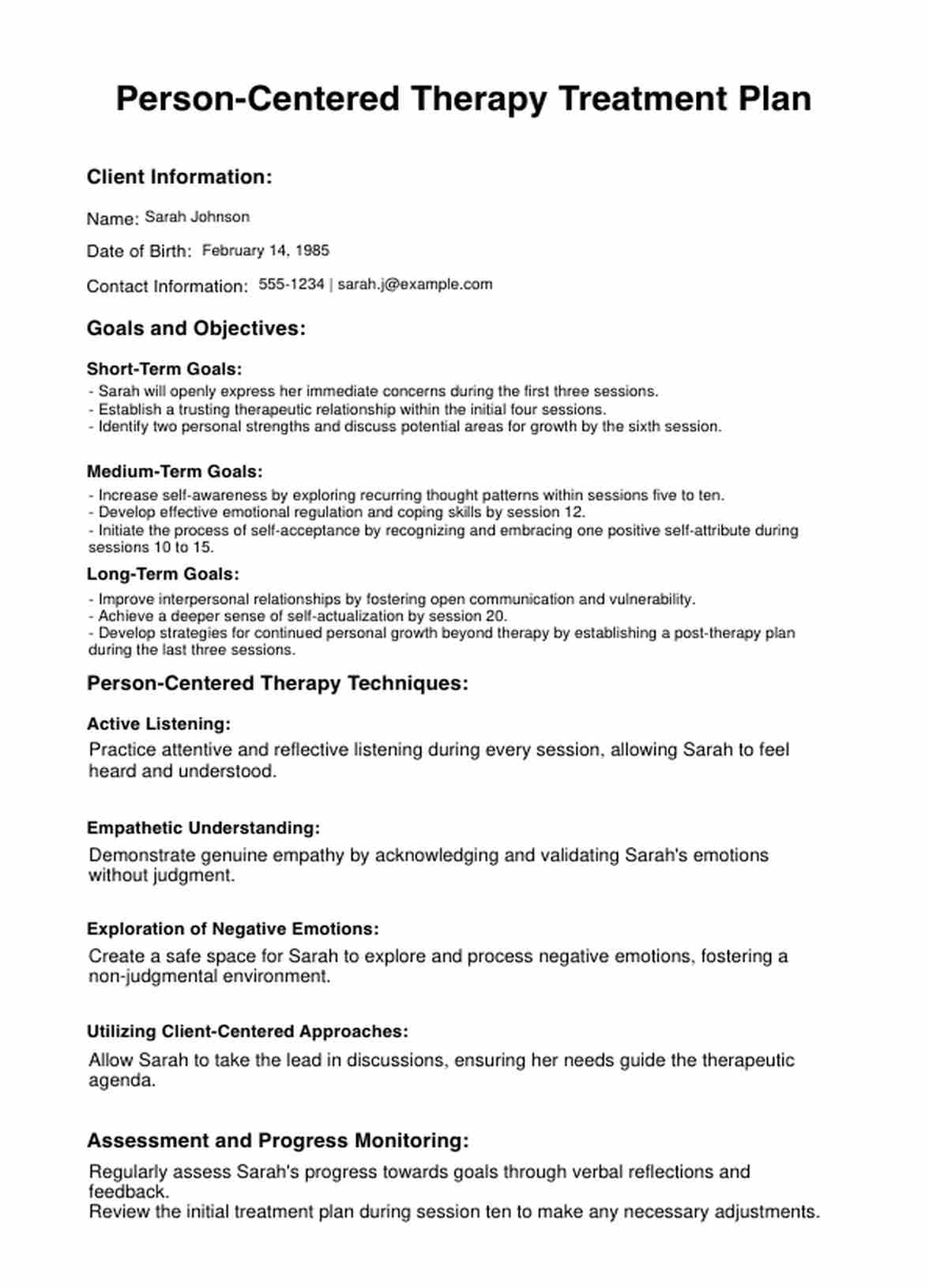

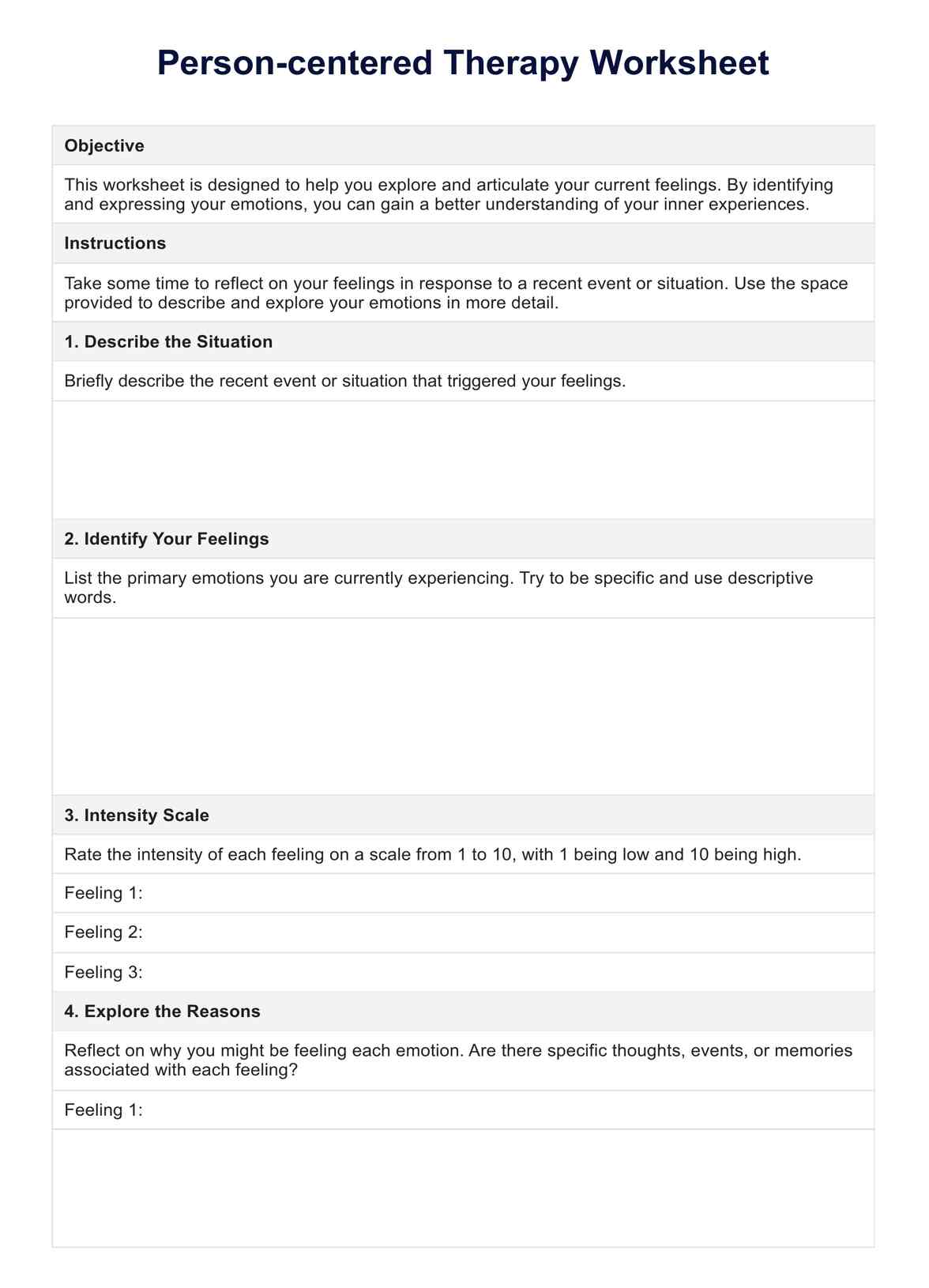
















-template.jpg)

























































































